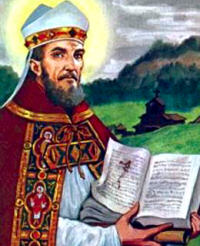
Readings for the Season
Friday of the seventh week of Easter
The
Divine
Office and The
Holy Spirit
J. D. Crichton
On the assumption that the Divine Office becomes in a future, near or far, the prayer of a great number of ordinary people, it will be seen that this is a kairos, a privileged moment for the reception of the Spirit. St Benedict, who in the sixth century provided the office for all monastic families of the West, was perfectly well aware of this.
Prayer, he says, should be pure and short 'unless it chance to be prolonged by the impulse and inspiration of divine grace', that is by the Holy Spirit. He thought of the calm and orderly celebration of the prayer as a quietening of the mind and the senses so that the monk could hear the voice of God in the psalms and in the readings and the Holy Spirit could make his presence known. That the revised office makes this possible can hardly be doubted.
The antiphon may be followed by a silence or there may be one at the end of the psalm before the psalm-collect, if it is used. Silence is recommended after the readings in morning or evening prayer and, of course, may be prolonged if the community so desires. But perhaps it is the intercessions that offer the most favourable opportunity for unstructured prayer when the official prayers have been said. There is no reason why the prayers of members of the community should not be uttered aloud.
This may not suit all communities but where 'charisrnatics' gather it would seem right that at least the first part of their prayer is structured and room left at this point for unstructured prayer. The community will have prayed the psalms 'in the Spirit', they will have listened to the reading by which the Holy Spirit is communicated to them, and they will be prepared to respond to the movement of the Spirit. They will, in the words of St Paul, be praying 'not only with the spirit but with the mind as well' (which he considered necessary) and the final result will be that the two forms of prayer, the liturgical and the charismatic, will be combined.
From; The Glenstall Book of Readings, The Once and the Future Liturgy,Veritas, Dublin, J977. Used by kind permission of the publisher.
liturgyinstitute.org/mgr-james-crichton/
There is some biographical material published on Mgr Crichton,.
“Anamnesis” ... J.D. Crichton's Significance for PastoralLiturgy in
England,. was defended by Fr ...
http://liturgyinstitute.org/




